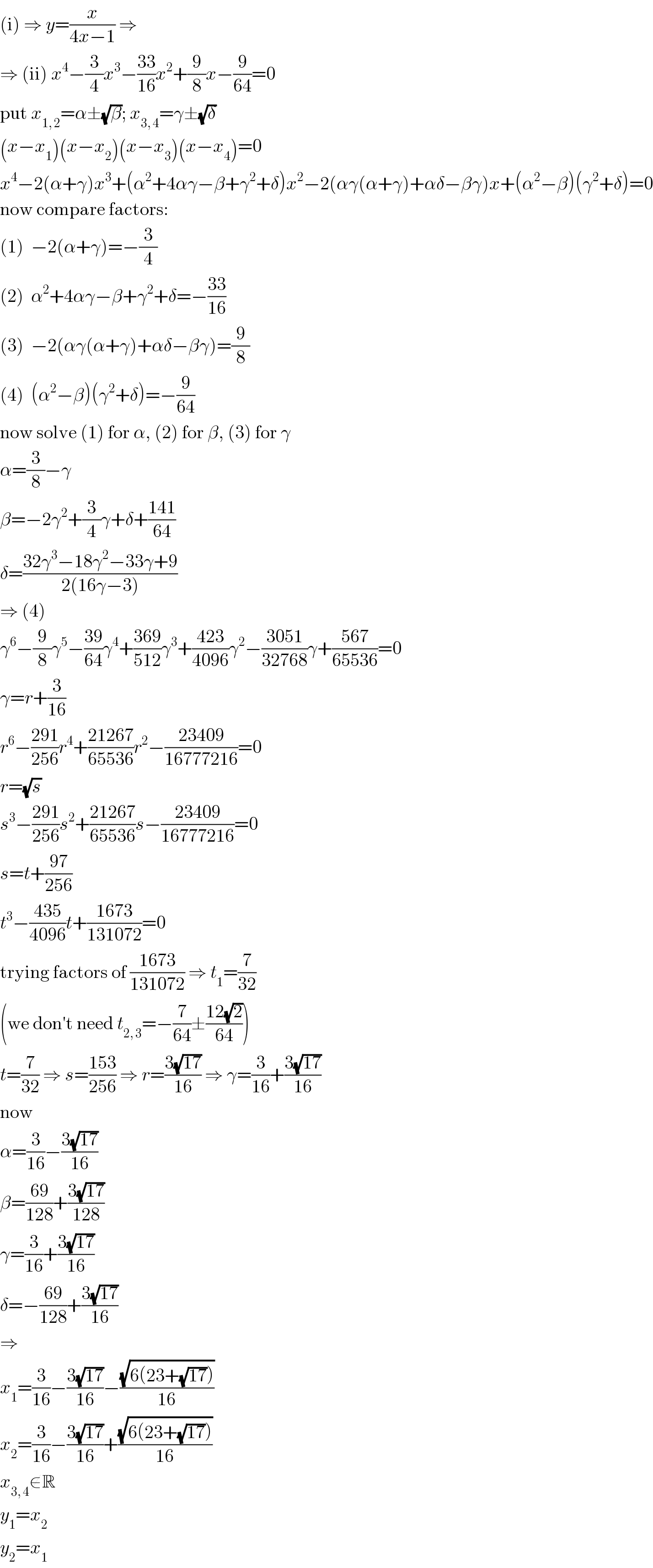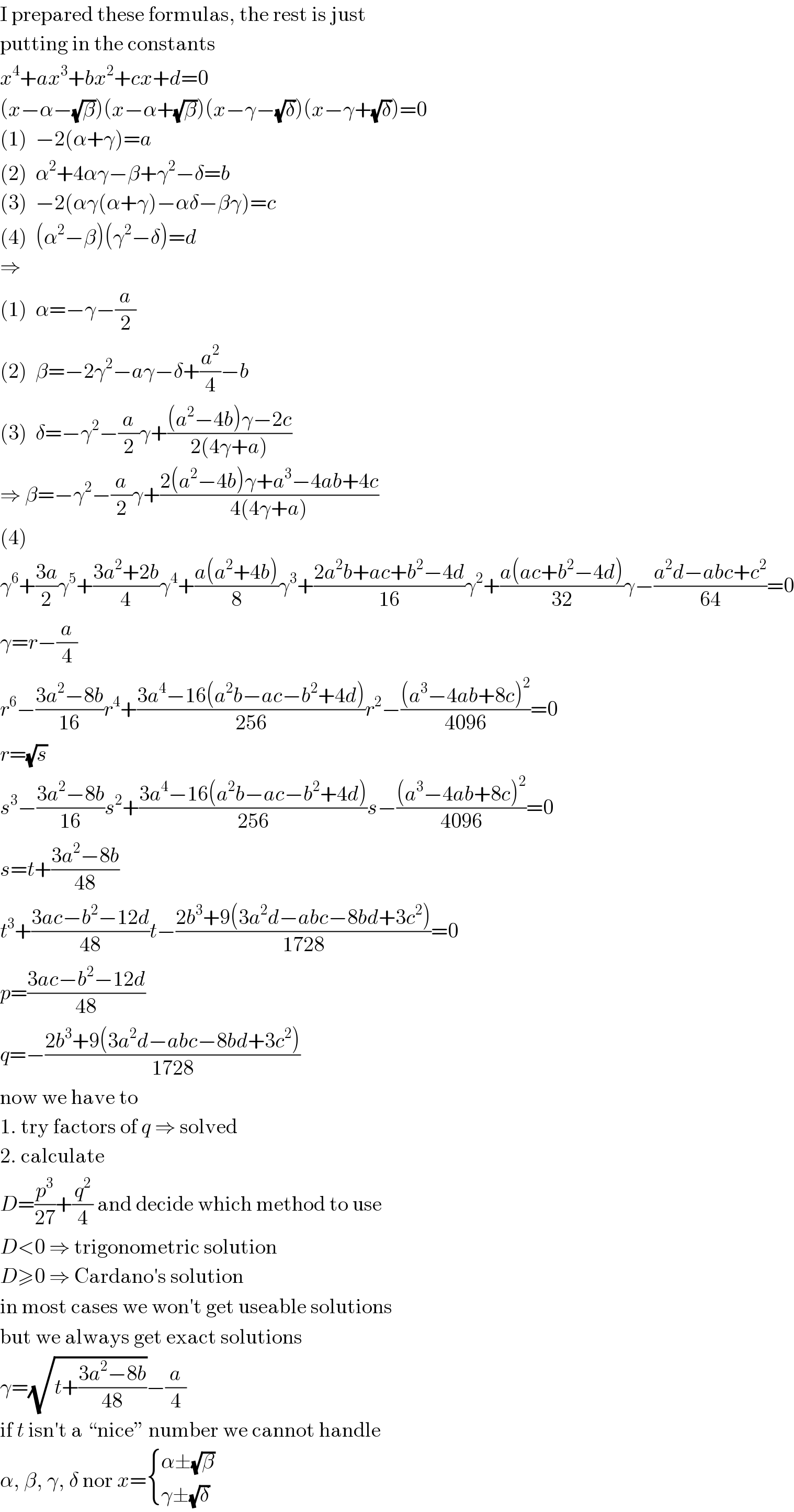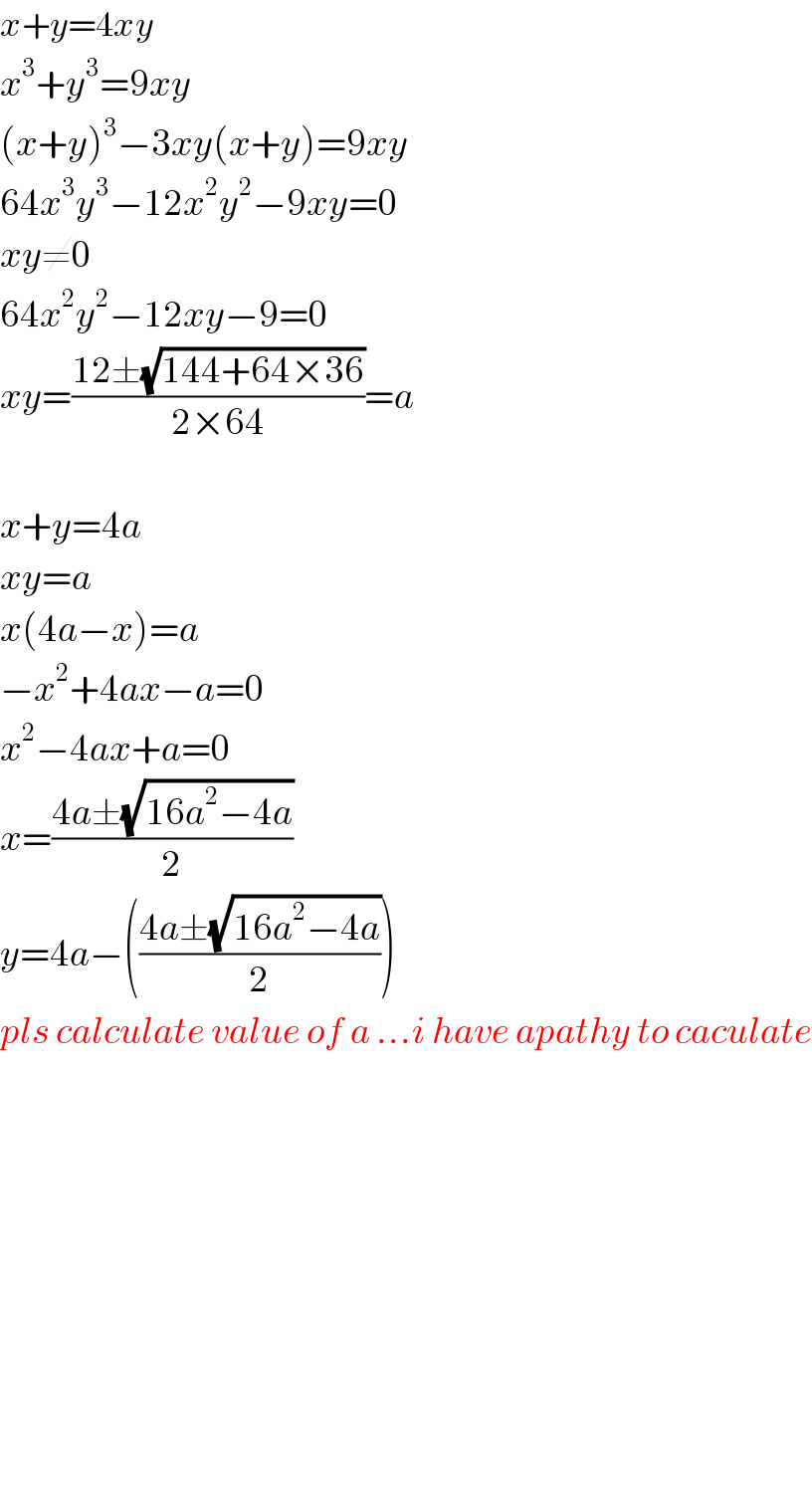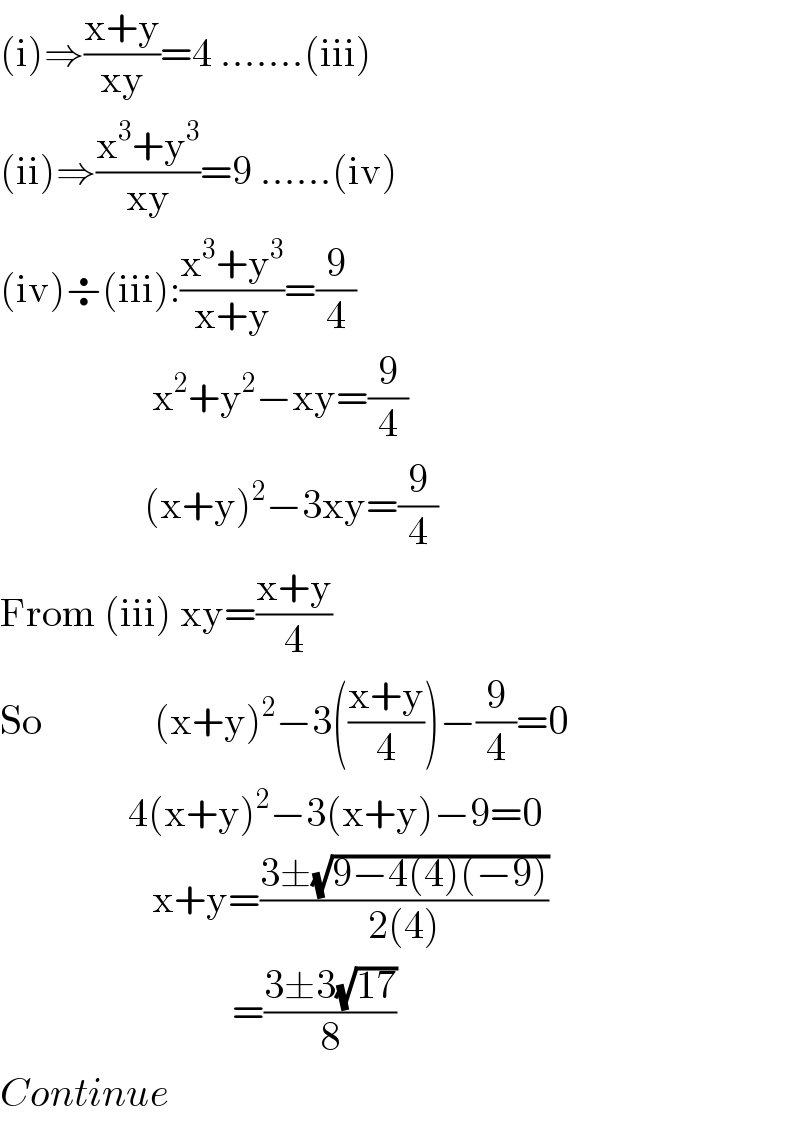Question Number 58529 by Tawa1 last updated on 24/Apr/19

$$\mathrm{Solve}\:\mathrm{for}\:\mathrm{x}\:\mathrm{and}\:\mathrm{y} \\ $$$$\:\:\:\:\:\:\:\:\:\:\:\frac{\mathrm{1}}{\mathrm{x}}\:+\:\frac{\mathrm{1}}{\mathrm{y}}\:=\:\mathrm{4}\:\:\:\:\:\:\:…….\:\left(\mathrm{i}\right) \\ $$$$\:\:\:\:\:\:\:\:\:\:\:\:\frac{\mathrm{x}^{\mathrm{2}} }{\mathrm{y}}\:+\:\frac{\mathrm{y}^{\mathrm{2}} }{\mathrm{x}}\:\:=\:\:\mathrm{9}\:\:\:\:\:\:…….\:\left(\mathrm{ii}\right) \\ $$
Commented by MJS last updated on 24/Apr/19

$$\mathrm{it}\:\mathrm{leads}\:\mathrm{to}\:\mathrm{an}\:\mathrm{exactly}\:\mathrm{solveable}\:\mathrm{polynome} \\ $$$$\mathrm{of}\:\mathrm{4}^{\mathrm{th}} \:\mathrm{degree}.\:\mathrm{I}\:\mathrm{will}\:\mathrm{show}\:\mathrm{later} \\ $$
Commented by Tawa1 last updated on 24/Apr/19

$$\mathrm{Waiting}\:\mathrm{sir}.\:\mathrm{God}\:\mathrm{bless}\:\mathrm{you} \\ $$
Commented by behi83417@gmail.com last updated on 25/Apr/19
![x+y=4xy x^3 +y^3 =9xy⇒[x+y=p,xy=q]⇒p^3 −3pq=9q ⇒ { ((p=4q)),((p^3 −3pq=9q⇒(4q)^3 −3(4q)q=9q)) :} ⇒64q^3 −12q^2 −9q=0⇒q(64q^2 −12q−9)=0 ⇒1)q=0⇒(x=0∨y=0,not ok for original question) ⇒2) 64q^2 −12q−9=0⇒q=((6±(√(36+9×64)))/(64)) ⇒[q=xy=3×((1±(√(17)))/(32))⇒p=x+y=3×((1±(√(17)))/8)] z^2 −(3/8)(1±(√(17)))z+(3/(32))(1±(√(17)))=0 z_(1,2) =(3/(16))[(1+(√(17)))±(√((1+(√(17)))^2 −(1+(√(17)))))] =(3/(16))[(1+(√(17)))±(√(17+(√(17))))] z_(3,4) =(3/(16))[(1−(√(17)))±(√((1−(√(17)))^2 −(1−(√(17)))))] =(3/(16))[(1−(√(17)))±(√(17−(√(17))))] z_(5,6) =(3/(16))[(1+(√(17)))±(√((1+(√(17)))^2 −(1−(√(17)))))] =(3/(16))[(1+(√(17)))±(√(17+3(√(17))))] z_(7,8) =(3/(16))[(1−(√(17)))±(√((1−(√(17)))^2 −(1+(√(17)))))] =(3/(16))[(1−(√(17)))±(√(17−3(√(17))))]](https://www.tinkutara.com/question/Q58566.png)
$${x}+{y}=\mathrm{4}{xy} \\ $$$${x}^{\mathrm{3}} +{y}^{\mathrm{3}} =\mathrm{9}{xy}\Rightarrow\left[{x}+{y}={p},{xy}={q}\right]\Rightarrow{p}^{\mathrm{3}} −\mathrm{3}{pq}=\mathrm{9}{q} \\ $$$$\Rightarrow\begin{cases}{{p}=\mathrm{4}{q}}\\{{p}^{\mathrm{3}} −\mathrm{3}{pq}=\mathrm{9}{q}\Rightarrow\left(\mathrm{4}{q}\right)^{\mathrm{3}} −\mathrm{3}\left(\mathrm{4}{q}\right){q}=\mathrm{9}{q}}\end{cases} \\ $$$$\Rightarrow\mathrm{64}{q}^{\mathrm{3}} −\mathrm{12}{q}^{\mathrm{2}} −\mathrm{9}{q}=\mathrm{0}\Rightarrow{q}\left(\mathrm{64}{q}^{\mathrm{2}} −\mathrm{12}{q}−\mathrm{9}\right)=\mathrm{0} \\ $$$$\left.\Rightarrow\mathrm{1}\right){q}=\mathrm{0}\Rightarrow\left({x}=\mathrm{0}\vee{y}=\mathrm{0},{not}\:{ok}\:{for}\:{original}\right. \\ $$$$\left.{question}\right) \\ $$$$\left.\Rightarrow\mathrm{2}\right)\:\mathrm{64}{q}^{\mathrm{2}} −\mathrm{12}{q}−\mathrm{9}=\mathrm{0}\Rightarrow{q}=\frac{\mathrm{6}\pm\sqrt{\mathrm{36}+\mathrm{9}×\mathrm{64}}}{\mathrm{64}} \\ $$$$\Rightarrow\left[{q}=\boldsymbol{\mathrm{xy}}=\mathrm{3}×\frac{\mathrm{1}\pm\sqrt{\mathrm{17}}}{\mathrm{32}}\Rightarrow{p}=\boldsymbol{\mathrm{x}}+\boldsymbol{\mathrm{y}}=\mathrm{3}×\frac{\mathrm{1}\pm\sqrt{\mathrm{17}}}{\mathrm{8}}\right] \\ $$$$\boldsymbol{\mathrm{z}}^{\mathrm{2}} −\frac{\mathrm{3}}{\mathrm{8}}\left(\mathrm{1}\pm\sqrt{\mathrm{17}}\right)\boldsymbol{\mathrm{z}}+\frac{\mathrm{3}}{\mathrm{32}}\left(\mathrm{1}\pm\sqrt{\mathrm{17}}\right)=\mathrm{0} \\ $$$$\boldsymbol{\mathrm{z}}_{\mathrm{1},\mathrm{2}} =\frac{\mathrm{3}}{\mathrm{16}}\left[\left(\mathrm{1}+\sqrt{\mathrm{17}}\right)\pm\sqrt{\left(\mathrm{1}+\sqrt{\mathrm{17}}\right)^{\mathrm{2}} −\left(\mathrm{1}+\sqrt{\mathrm{17}}\right)}\right] \\ $$$$=\frac{\mathrm{3}}{\mathrm{16}}\left[\left(\mathrm{1}+\sqrt{\mathrm{17}}\right)\pm\sqrt{\mathrm{17}+\sqrt{\mathrm{17}}}\right] \\ $$$$\boldsymbol{\mathrm{z}}_{\mathrm{3},\mathrm{4}} =\frac{\mathrm{3}}{\mathrm{16}}\left[\left(\mathrm{1}−\sqrt{\mathrm{17}}\right)\pm\sqrt{\left(\mathrm{1}−\sqrt{\mathrm{17}}\right)^{\mathrm{2}} −\left(\mathrm{1}−\sqrt{\mathrm{17}}\right)}\right] \\ $$$$=\frac{\mathrm{3}}{\mathrm{16}}\left[\left(\mathrm{1}−\sqrt{\mathrm{17}}\right)\pm\sqrt{\mathrm{17}−\sqrt{\mathrm{17}}}\right] \\ $$$$\boldsymbol{\mathrm{z}}_{\mathrm{5},\mathrm{6}} =\frac{\mathrm{3}}{\mathrm{16}}\left[\left(\mathrm{1}+\sqrt{\mathrm{17}}\right)\pm\sqrt{\left(\mathrm{1}+\sqrt{\mathrm{17}}\right)^{\mathrm{2}} −\left(\mathrm{1}−\sqrt{\mathrm{17}}\right)}\right] \\ $$$$=\frac{\mathrm{3}}{\mathrm{16}}\left[\left(\mathrm{1}+\sqrt{\mathrm{17}}\right)\pm\sqrt{\mathrm{17}+\mathrm{3}\sqrt{\mathrm{17}}}\right] \\ $$$$\boldsymbol{\mathrm{z}}_{\mathrm{7},\mathrm{8}} =\frac{\mathrm{3}}{\mathrm{16}}\left[\left(\mathrm{1}−\sqrt{\mathrm{17}}\right)\pm\sqrt{\left(\mathrm{1}−\sqrt{\mathrm{17}}\right)^{\mathrm{2}} −\left(\mathrm{1}+\sqrt{\mathrm{17}}\right)}\right] \\ $$$$=\frac{\mathrm{3}}{\mathrm{16}}\left[\left(\mathrm{1}−\sqrt{\mathrm{17}}\right)\pm\sqrt{\mathrm{17}−\mathrm{3}\sqrt{\mathrm{17}}}\right] \\ $$
Commented by Tawa1 last updated on 25/Apr/19

$$\mathrm{God}\:\mathrm{bless}\:\mathrm{you}\:\mathrm{sir} \\ $$
Answered by MJS last updated on 25/Apr/19

$$\left(\mathrm{i}\right)\:\Rightarrow\:{y}=\frac{{x}}{\mathrm{4}{x}−\mathrm{1}}\:\Rightarrow \\ $$$$\Rightarrow\:\left(\mathrm{ii}\right)\:{x}^{\mathrm{4}} −\frac{\mathrm{3}}{\mathrm{4}}{x}^{\mathrm{3}} −\frac{\mathrm{33}}{\mathrm{16}}{x}^{\mathrm{2}} +\frac{\mathrm{9}}{\mathrm{8}}{x}−\frac{\mathrm{9}}{\mathrm{64}}=\mathrm{0} \\ $$$$\mathrm{put}\:{x}_{\mathrm{1},\:\mathrm{2}} =\alpha\pm\sqrt{\beta};\:{x}_{\mathrm{3},\:\mathrm{4}} =\gamma\pm\sqrt{\delta} \\ $$$$\left({x}−{x}_{\mathrm{1}} \right)\left({x}−{x}_{\mathrm{2}} \right)\left({x}−{x}_{\mathrm{3}} \right)\left({x}−{x}_{\mathrm{4}} \right)=\mathrm{0} \\ $$$${x}^{\mathrm{4}} −\mathrm{2}\left(\alpha+\gamma\right){x}^{\mathrm{3}} +\left(\alpha^{\mathrm{2}} +\mathrm{4}\alpha\gamma−\beta+\gamma^{\mathrm{2}} +\delta\right){x}^{\mathrm{2}} −\mathrm{2}\left(\alpha\gamma\left(\alpha+\gamma\right)+\alpha\delta−\beta\gamma\right){x}+\left(\alpha^{\mathrm{2}} −\beta\right)\left(\gamma^{\mathrm{2}} +\delta\right)=\mathrm{0} \\ $$$$\mathrm{now}\:\mathrm{compare}\:\mathrm{factors}: \\ $$$$\left(\mathrm{1}\right)\:\:−\mathrm{2}\left(\alpha+\gamma\right)=−\frac{\mathrm{3}}{\mathrm{4}} \\ $$$$\left(\mathrm{2}\right)\:\:\alpha^{\mathrm{2}} +\mathrm{4}\alpha\gamma−\beta+\gamma^{\mathrm{2}} +\delta=−\frac{\mathrm{33}}{\mathrm{16}} \\ $$$$\left(\mathrm{3}\right)\:\:−\mathrm{2}\left(\alpha\gamma\left(\alpha+\gamma\right)+\alpha\delta−\beta\gamma\right)=\frac{\mathrm{9}}{\mathrm{8}} \\ $$$$\left(\mathrm{4}\right)\:\:\left(\alpha^{\mathrm{2}} −\beta\right)\left(\gamma^{\mathrm{2}} +\delta\right)=−\frac{\mathrm{9}}{\mathrm{64}} \\ $$$$\mathrm{now}\:\mathrm{solve}\:\left(\mathrm{1}\right)\:\mathrm{for}\:\alpha,\:\left(\mathrm{2}\right)\:\mathrm{for}\:\beta,\:\left(\mathrm{3}\right)\:\mathrm{for}\:\gamma \\ $$$$\alpha=\frac{\mathrm{3}}{\mathrm{8}}−\gamma \\ $$$$\beta=−\mathrm{2}\gamma^{\mathrm{2}} +\frac{\mathrm{3}}{\mathrm{4}}\gamma+\delta+\frac{\mathrm{141}}{\mathrm{64}} \\ $$$$\delta=\frac{\mathrm{32}\gamma^{\mathrm{3}} −\mathrm{18}\gamma^{\mathrm{2}} −\mathrm{33}\gamma+\mathrm{9}}{\mathrm{2}\left(\mathrm{16}\gamma−\mathrm{3}\right)} \\ $$$$\Rightarrow\:\left(\mathrm{4}\right) \\ $$$$\gamma^{\mathrm{6}} −\frac{\mathrm{9}}{\mathrm{8}}\gamma^{\mathrm{5}} −\frac{\mathrm{39}}{\mathrm{64}}\gamma^{\mathrm{4}} +\frac{\mathrm{369}}{\mathrm{512}}\gamma^{\mathrm{3}} +\frac{\mathrm{423}}{\mathrm{4096}}\gamma^{\mathrm{2}} −\frac{\mathrm{3051}}{\mathrm{32768}}\gamma+\frac{\mathrm{567}}{\mathrm{65536}}=\mathrm{0} \\ $$$$\gamma={r}+\frac{\mathrm{3}}{\mathrm{16}} \\ $$$${r}^{\mathrm{6}} −\frac{\mathrm{291}}{\mathrm{256}}{r}^{\mathrm{4}} +\frac{\mathrm{21267}}{\mathrm{65536}}{r}^{\mathrm{2}} −\frac{\mathrm{23409}}{\mathrm{16777216}}=\mathrm{0} \\ $$$${r}=\sqrt{{s}} \\ $$$${s}^{\mathrm{3}} −\frac{\mathrm{291}}{\mathrm{256}}{s}^{\mathrm{2}} +\frac{\mathrm{21267}}{\mathrm{65536}}{s}−\frac{\mathrm{23409}}{\mathrm{16777216}}=\mathrm{0} \\ $$$${s}={t}+\frac{\mathrm{97}}{\mathrm{256}} \\ $$$${t}^{\mathrm{3}} −\frac{\mathrm{435}}{\mathrm{4096}}{t}+\frac{\mathrm{1673}}{\mathrm{131072}}=\mathrm{0} \\ $$$$\mathrm{trying}\:\mathrm{factors}\:\mathrm{of}\:\frac{\mathrm{1673}}{\mathrm{131072}}\:\Rightarrow\:{t}_{\mathrm{1}} =\frac{\mathrm{7}}{\mathrm{32}} \\ $$$$\left(\mathrm{we}\:\mathrm{don}'\mathrm{t}\:\mathrm{need}\:{t}_{\mathrm{2},\:\mathrm{3}} =−\frac{\mathrm{7}}{\mathrm{64}}\pm\frac{\mathrm{12}\sqrt{\mathrm{2}}}{\mathrm{64}}\right) \\ $$$${t}=\frac{\mathrm{7}}{\mathrm{32}}\:\Rightarrow\:{s}=\frac{\mathrm{153}}{\mathrm{256}}\:\Rightarrow\:{r}=\frac{\mathrm{3}\sqrt{\mathrm{17}}}{\mathrm{16}}\:\Rightarrow\:\gamma=\frac{\mathrm{3}}{\mathrm{16}}+\frac{\mathrm{3}\sqrt{\mathrm{17}}}{\mathrm{16}} \\ $$$$\mathrm{now} \\ $$$$\alpha=\frac{\mathrm{3}}{\mathrm{16}}−\frac{\mathrm{3}\sqrt{\mathrm{17}}}{\mathrm{16}} \\ $$$$\beta=\frac{\mathrm{69}}{\mathrm{128}}+\frac{\mathrm{3}\sqrt{\mathrm{17}}}{\mathrm{128}} \\ $$$$\gamma=\frac{\mathrm{3}}{\mathrm{16}}+\frac{\mathrm{3}\sqrt{\mathrm{17}}}{\mathrm{16}} \\ $$$$\delta=−\frac{\mathrm{69}}{\mathrm{128}}+\frac{\mathrm{3}\sqrt{\mathrm{17}}}{\mathrm{16}} \\ $$$$\Rightarrow \\ $$$${x}_{\mathrm{1}} =\frac{\mathrm{3}}{\mathrm{16}}−\frac{\mathrm{3}\sqrt{\mathrm{17}}}{\mathrm{16}}−\frac{\sqrt{\mathrm{6}\left(\mathrm{23}+\sqrt{\mathrm{17}}\right)}}{\mathrm{16}} \\ $$$${x}_{\mathrm{2}} =\frac{\mathrm{3}}{\mathrm{16}}−\frac{\mathrm{3}\sqrt{\mathrm{17}}}{\mathrm{16}}+\frac{\sqrt{\mathrm{6}\left(\mathrm{23}+\sqrt{\mathrm{17}}\right)}}{\mathrm{16}} \\ $$$${x}_{\mathrm{3},\:\mathrm{4}} \notin\mathbb{R} \\ $$$${y}_{\mathrm{1}} ={x}_{\mathrm{2}} \\ $$$${y}_{\mathrm{2}} ={x}_{\mathrm{1}} \\ $$
Commented by MJS last updated on 25/Apr/19

$$\mathrm{I}\:\mathrm{prepared}\:\mathrm{these}\:\mathrm{formulas},\:\mathrm{the}\:\mathrm{rest}\:\mathrm{is}\:\mathrm{just} \\ $$$$\mathrm{putting}\:\mathrm{in}\:\mathrm{the}\:\mathrm{constants} \\ $$$${x}^{\mathrm{4}} +{ax}^{\mathrm{3}} +{bx}^{\mathrm{2}} +{cx}+{d}=\mathrm{0} \\ $$$$\left({x}−\alpha−\sqrt{\beta}\right)\left({x}−\alpha+\sqrt{\beta}\right)\left({x}−\gamma−\sqrt{\delta}\right)\left({x}−\gamma+\sqrt{\delta}\right)=\mathrm{0} \\ $$$$\left(\mathrm{1}\right)\:\:−\mathrm{2}\left(\alpha+\gamma\right)={a} \\ $$$$\left(\mathrm{2}\right)\:\:\alpha^{\mathrm{2}} +\mathrm{4}\alpha\gamma−\beta+\gamma^{\mathrm{2}} −\delta={b} \\ $$$$\left(\mathrm{3}\right)\:\:−\mathrm{2}\left(\alpha\gamma\left(\alpha+\gamma\right)−\alpha\delta−\beta\gamma\right)={c} \\ $$$$\left(\mathrm{4}\right)\:\:\left(\alpha^{\mathrm{2}} −\beta\right)\left(\gamma^{\mathrm{2}} −\delta\right)={d} \\ $$$$\Rightarrow \\ $$$$\left(\mathrm{1}\right)\:\:\alpha=−\gamma−\frac{{a}}{\mathrm{2}} \\ $$$$\left(\mathrm{2}\right)\:\:\beta=−\mathrm{2}\gamma^{\mathrm{2}} −{a}\gamma−\delta+\frac{{a}^{\mathrm{2}} }{\mathrm{4}}−{b} \\ $$$$\left(\mathrm{3}\right)\:\:\delta=−\gamma^{\mathrm{2}} −\frac{{a}}{\mathrm{2}}\gamma+\frac{\left({a}^{\mathrm{2}} −\mathrm{4}{b}\right)\gamma−\mathrm{2}{c}}{\mathrm{2}\left(\mathrm{4}\gamma+{a}\right)} \\ $$$$\Rightarrow\:\beta=−\gamma^{\mathrm{2}} −\frac{{a}}{\mathrm{2}}\gamma+\frac{\mathrm{2}\left({a}^{\mathrm{2}} −\mathrm{4}{b}\right)\gamma+{a}^{\mathrm{3}} −\mathrm{4}{ab}+\mathrm{4}{c}}{\mathrm{4}\left(\mathrm{4}\gamma+{a}\right)} \\ $$$$\left(\mathrm{4}\right) \\ $$$$\gamma^{\mathrm{6}} +\frac{\mathrm{3}{a}}{\mathrm{2}}\gamma^{\mathrm{5}} +\frac{\mathrm{3}{a}^{\mathrm{2}} +\mathrm{2}{b}}{\mathrm{4}}\gamma^{\mathrm{4}} +\frac{{a}\left({a}^{\mathrm{2}} +\mathrm{4}{b}\right)}{\mathrm{8}}\gamma^{\mathrm{3}} +\frac{\mathrm{2}{a}^{\mathrm{2}} {b}+{ac}+{b}^{\mathrm{2}} −\mathrm{4}{d}}{\mathrm{16}}\gamma^{\mathrm{2}} +\frac{{a}\left({ac}+{b}^{\mathrm{2}} −\mathrm{4}{d}\right)}{\mathrm{32}}\gamma−\frac{{a}^{\mathrm{2}} {d}−{abc}+{c}^{\mathrm{2}} }{\mathrm{64}}=\mathrm{0} \\ $$$$\gamma={r}−\frac{{a}}{\mathrm{4}} \\ $$$${r}^{\mathrm{6}} −\frac{\mathrm{3}{a}^{\mathrm{2}} −\mathrm{8}{b}}{\mathrm{16}}{r}^{\mathrm{4}} +\frac{\mathrm{3}{a}^{\mathrm{4}} −\mathrm{16}\left({a}^{\mathrm{2}} {b}−{ac}−{b}^{\mathrm{2}} +\mathrm{4}{d}\right)}{\mathrm{256}}{r}^{\mathrm{2}} −\frac{\left({a}^{\mathrm{3}} −\mathrm{4}{ab}+\mathrm{8}{c}\right)^{\mathrm{2}} }{\mathrm{4096}}=\mathrm{0} \\ $$$${r}=\sqrt{{s}} \\ $$$${s}^{\mathrm{3}} −\frac{\mathrm{3}{a}^{\mathrm{2}} −\mathrm{8}{b}}{\mathrm{16}}{s}^{\mathrm{2}} +\frac{\mathrm{3}{a}^{\mathrm{4}} −\mathrm{16}\left({a}^{\mathrm{2}} {b}−{ac}−{b}^{\mathrm{2}} +\mathrm{4}{d}\right)}{\mathrm{256}}{s}−\frac{\left({a}^{\mathrm{3}} −\mathrm{4}{ab}+\mathrm{8}{c}\right)^{\mathrm{2}} }{\mathrm{4096}}=\mathrm{0} \\ $$$${s}={t}+\frac{\mathrm{3}{a}^{\mathrm{2}} −\mathrm{8}{b}}{\mathrm{48}} \\ $$$${t}^{\mathrm{3}} +\frac{\mathrm{3}{ac}−{b}^{\mathrm{2}} −\mathrm{12}{d}}{\mathrm{48}}{t}−\frac{\mathrm{2}{b}^{\mathrm{3}} +\mathrm{9}\left(\mathrm{3}{a}^{\mathrm{2}} {d}−{abc}−\mathrm{8}{bd}+\mathrm{3}{c}^{\mathrm{2}} \right)}{\mathrm{1728}}=\mathrm{0} \\ $$$${p}=\frac{\mathrm{3}{ac}−{b}^{\mathrm{2}} −\mathrm{12}{d}}{\mathrm{48}} \\ $$$${q}=−\frac{\mathrm{2}{b}^{\mathrm{3}} +\mathrm{9}\left(\mathrm{3}{a}^{\mathrm{2}} {d}−{abc}−\mathrm{8}{bd}+\mathrm{3}{c}^{\mathrm{2}} \right)}{\mathrm{1728}} \\ $$$$\mathrm{now}\:\mathrm{we}\:\mathrm{have}\:\mathrm{to} \\ $$$$\mathrm{1}.\:\mathrm{try}\:\mathrm{factors}\:\mathrm{of}\:{q}\:\Rightarrow\:\mathrm{solved} \\ $$$$\mathrm{2}.\:\mathrm{calculate} \\ $$$${D}=\frac{{p}^{\mathrm{3}} }{\mathrm{27}}+\frac{{q}^{\mathrm{2}} }{\mathrm{4}}\:\mathrm{and}\:\mathrm{decide}\:\mathrm{which}\:\mathrm{method}\:\mathrm{to}\:\mathrm{use} \\ $$$${D}<\mathrm{0}\:\Rightarrow\:\mathrm{trigonometric}\:\mathrm{solution} \\ $$$${D}\geqslant\mathrm{0}\:\Rightarrow\:\mathrm{Cardano}'\mathrm{s}\:\mathrm{solution} \\ $$$$\mathrm{in}\:\mathrm{most}\:\mathrm{cases}\:\mathrm{we}\:\mathrm{won}'\mathrm{t}\:\mathrm{get}\:\mathrm{useable}\:\mathrm{solutions} \\ $$$$\mathrm{but}\:\mathrm{we}\:\mathrm{always}\:\mathrm{get}\:\mathrm{exact}\:\mathrm{solutions} \\ $$$$\gamma=\sqrt{{t}+\frac{\mathrm{3}{a}^{\mathrm{2}} −\mathrm{8}{b}}{\mathrm{48}}}−\frac{{a}}{\mathrm{4}} \\ $$$$\mathrm{if}\:{t}\:\mathrm{isn}'\mathrm{t}\:\mathrm{a}\:“\mathrm{nice}''\:\mathrm{number}\:\mathrm{we}\:\mathrm{cannot}\:\mathrm{handle} \\ $$$$\alpha,\:\beta,\:\gamma,\:\delta\:\mathrm{nor}\:{x}=\begin{cases}{\alpha\pm\sqrt{\beta}}\\{\gamma\pm\sqrt{\delta}}\end{cases} \\ $$
Commented by Tawa1 last updated on 24/Apr/19

$$\mathrm{God}\:\mathrm{bless}\:\mathrm{you}\:\mathrm{sir},\:\mathrm{i}\:\mathrm{appreciate}\:\mathrm{your}\:\mathrm{time}\:\mathrm{sir} \\ $$
Commented by tanmay last updated on 25/Apr/19

$${without}\:{using}\:{calculator}\:{how}\:{to}\:{solve}\:{this}\:{problem}? \\ $$$${is}\:{it}\:{feasible}\:{to}\:{caculate}\:{such}\:{big}\:{number} \\ $$$$\mathrm{65536},\mathrm{16777216},\mathrm{33768}\:{etc}\:{to}\:{calculate}\:{by}\:{simple} \\ $$$$+,−,×,/\:{etc} \\ $$$$ \\ $$
Commented by tanmay last updated on 25/Apr/19

$${ok}\:{sir} \\ $$
Answered by tanmay last updated on 24/Apr/19

$${x}+{y}=\mathrm{4}{xy} \\ $$$${x}^{\mathrm{3}} +{y}^{\mathrm{3}} =\mathrm{9}{xy} \\ $$$$\left({x}+{y}\right)^{\mathrm{3}} −\mathrm{3}{xy}\left({x}+{y}\right)=\mathrm{9}{xy} \\ $$$$\mathrm{64}{x}^{\mathrm{3}} {y}^{\mathrm{3}} −\mathrm{12}{x}^{\mathrm{2}} {y}^{\mathrm{2}} −\mathrm{9}{xy}=\mathrm{0} \\ $$$${xy}\neq\mathrm{0} \\ $$$$\mathrm{64}{x}^{\mathrm{2}} {y}^{\mathrm{2}} −\mathrm{12}{xy}−\mathrm{9}=\mathrm{0} \\ $$$${xy}=\frac{\mathrm{12}\pm\sqrt{\mathrm{144}+\mathrm{64}×\mathrm{36}}}{\mathrm{2}×\mathrm{64}}={a} \\ $$$$ \\ $$$${x}+{y}=\mathrm{4}{a} \\ $$$${xy}={a} \\ $$$${x}\left(\mathrm{4}{a}−{x}\right)={a} \\ $$$$−{x}^{\mathrm{2}} +\mathrm{4}{ax}−{a}=\mathrm{0} \\ $$$${x}^{\mathrm{2}} −\mathrm{4}{ax}+{a}=\mathrm{0} \\ $$$${x}=\frac{\mathrm{4}{a}\pm\sqrt{\mathrm{16}{a}^{\mathrm{2}} −\mathrm{4}{a}}}{\mathrm{2}} \\ $$$${y}=\mathrm{4}{a}−\left(\frac{\mathrm{4}{a}\pm\sqrt{\mathrm{16}{a}^{\mathrm{2}} −\mathrm{4}{a}}}{\mathrm{2}}\right) \\ $$$${pls}\:{calculate}\:{value}\:{of}\:{a}\:…{i}\:{have}\:{apathy}\:{to}\:{caculate} \\ $$$$ \\ $$$$ \\ $$$$ \\ $$$$ \\ $$$$ \\ $$$$ \\ $$$$ \\ $$$$ \\ $$
Commented by Tawa1 last updated on 24/Apr/19

$$\mathrm{God}\:\mathrm{bless}\:\mathrm{you}\:\mathrm{sir} \\ $$
Answered by Rasheed.Sindhi last updated on 24/Apr/19

$$\left(\mathrm{i}\right)\Rightarrow\frac{\mathrm{x}+\mathrm{y}}{\mathrm{xy}}=\mathrm{4}\:…….\left(\mathrm{iii}\right) \\ $$$$\left(\mathrm{ii}\right)\Rightarrow\frac{\mathrm{x}^{\mathrm{3}} +\mathrm{y}^{\mathrm{3}} }{\mathrm{xy}}=\mathrm{9}\:……\left(\mathrm{iv}\right) \\ $$$$\left(\mathrm{iv}\right)\boldsymbol{\div}\left(\mathrm{iii}\right):\frac{\mathrm{x}^{\mathrm{3}} +\mathrm{y}^{\mathrm{3}} }{\mathrm{x}+\mathrm{y}}=\frac{\mathrm{9}}{\mathrm{4}} \\ $$$$\:\:\:\:\:\:\:\:\:\:\:\:\:\:\:\:\:\:\:\mathrm{x}^{\mathrm{2}} +\mathrm{y}^{\mathrm{2}} −\mathrm{xy}=\frac{\mathrm{9}}{\mathrm{4}} \\ $$$$\:\:\:\:\:\:\:\:\:\:\:\:\:\:\:\:\:\:\left(\mathrm{x}+\mathrm{y}\right)^{\mathrm{2}} −\mathrm{3xy}=\frac{\mathrm{9}}{\mathrm{4}} \\ $$$$\mathrm{From}\:\left(\mathrm{iii}\right)\:\mathrm{xy}=\frac{\mathrm{x}+\mathrm{y}}{\mathrm{4}} \\ $$$$\mathrm{So}\:\:\:\:\:\:\:\:\:\:\:\:\:\:\left(\mathrm{x}+\mathrm{y}\right)^{\mathrm{2}} −\mathrm{3}\left(\frac{\mathrm{x}+\mathrm{y}}{\mathrm{4}}\right)−\frac{\mathrm{9}}{\mathrm{4}}=\mathrm{0} \\ $$$$\:\:\:\:\:\:\:\:\:\:\:\:\:\:\:\:\mathrm{4}\left(\mathrm{x}+\mathrm{y}\right)^{\mathrm{2}} −\mathrm{3}\left(\mathrm{x}+\mathrm{y}\right)−\mathrm{9}=\mathrm{0} \\ $$$$\:\:\:\:\:\:\:\:\:\:\:\:\:\:\:\:\:\:\:\mathrm{x}+\mathrm{y}=\frac{\mathrm{3}\pm\sqrt{\mathrm{9}−\mathrm{4}\left(\mathrm{4}\right)\left(−\mathrm{9}\right)}}{\mathrm{2}\left(\mathrm{4}\right)} \\ $$$$\:\:\:\:\:\:\:\:\:\:\:\:\:\:\:\:\:\:\:\:\:\:\:\:\:\:\:\:\:=\frac{\mathrm{3}\pm\mathrm{3}\sqrt{\mathrm{17}}}{\mathrm{8}} \\ $$$${Continue} \\ $$
Commented by Tawa1 last updated on 24/Apr/19

$$\mathrm{God}\:\mathrm{bless}\:\mathrm{you}\:\mathrm{sir} \\ $$
